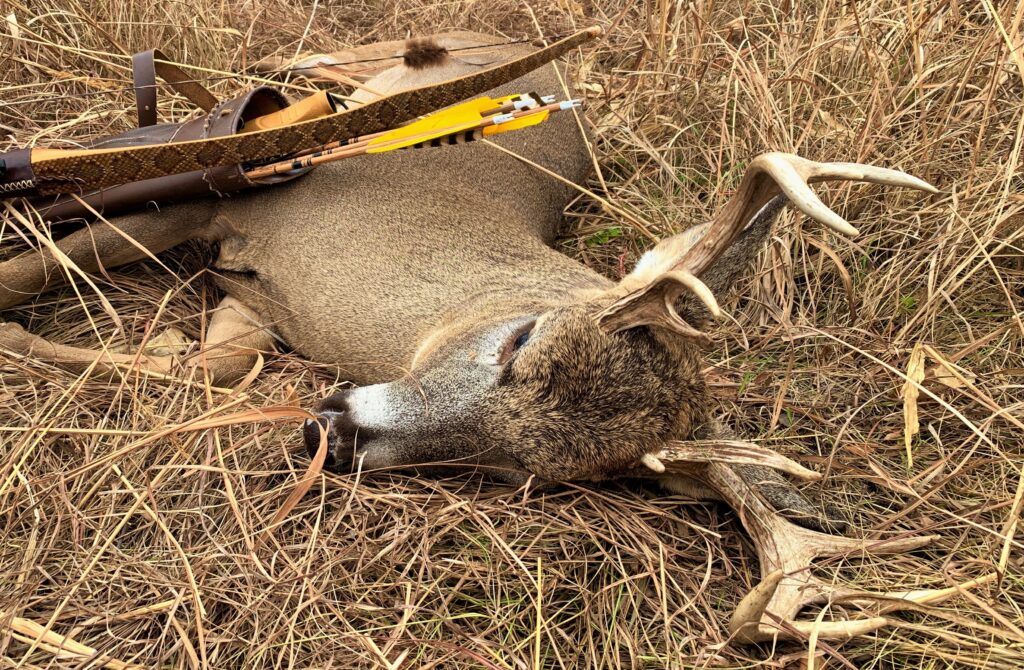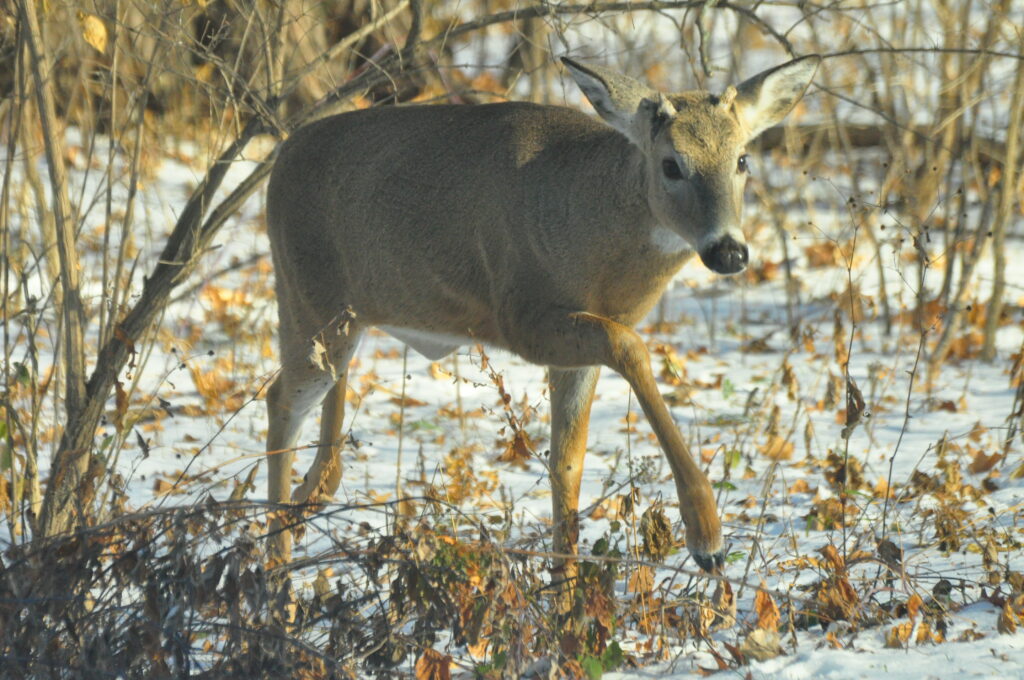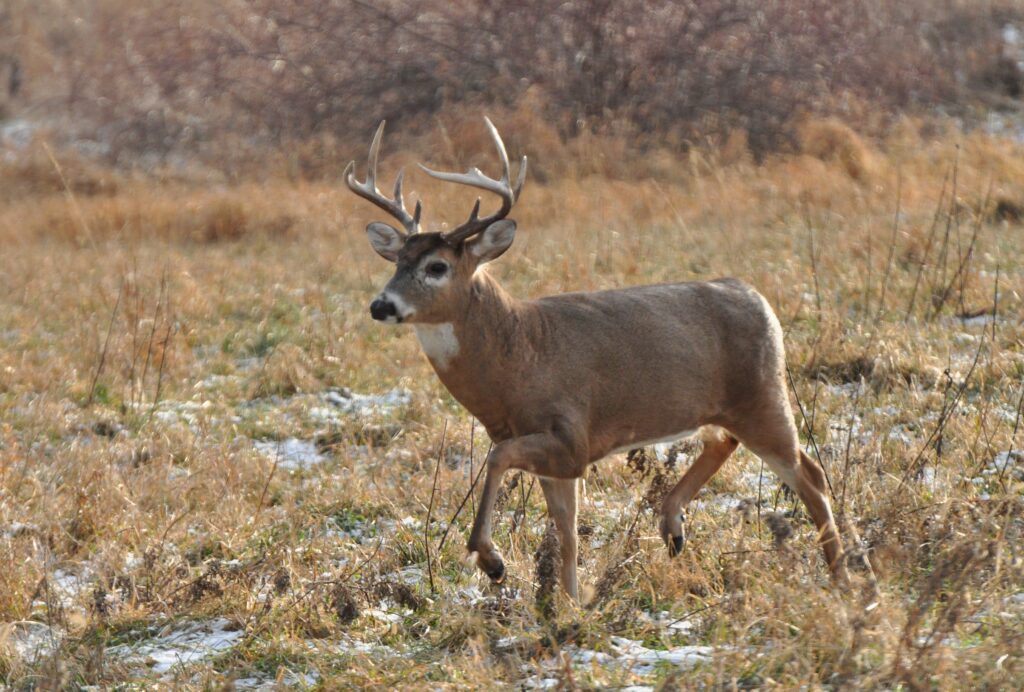Photography courtesy of Lowell Washburn, all rights reserved.
Those of us who pursue ducks, geese, or wild turkeys are well acquainted with the effectiveness of game calling. Game calling is so important, in fact, that most waterfowl or turkey hunters utilize — not just one — but rather carry several calls in order to meet the ever-changing challenges that accompany the particular species they seek.
That’s why it seems especially odd that out of Iowa’s 60,000 plus archery deer hunters, only a fraction of those bow hunting enthusiasts routinely use calls in an attempt to deceive wary white-tails. For me, calling is an essential part of spending a day in the timber. To watch a cruising buck suddenly change direction and trot directly to the sound of your call – even when it’s an animal you have no intention of shooting – can add a distinct element of excitement to what would have otherwise been a lackluster outing.
Deer calling employs two basic tools which includes some type of traditional tube call and a set of antlers for rattling. Either call type can be effectively used in conjunction with the other. The whole idea is to mimic sounds that occur naturally in the wild.
Tube Calls: Although there are many so-called snort, grunt and wheeze calls, the majority of tube-type deer calls are designed to imitate the basic vocalizations of a rutting buck – which are sounds that closely approximate the contented grunting of a domestic hog. Although there are a wide variety of such calls on the market, I only use two – the Griebel Game Calls’ Rut Stopper and Hunter Specialties’ True Talker. Both are affordable, easy to blow calls that provide realistic sounds that will bring bucks to your stand.

Although I’m far from an expert at deer calling, I have enjoyed success while using both calls. Regardless of whether I’m calling blind in thick cover or trying to gain the attention of a deer I’ve spotted at a distance, I usually begin with a basic, four note series. For those of you who can still remember the old crank-up, party line wall phones; the calling scenario would be the equivalent of ‘one long, and three shorts’. If that last sentence made absolutely no sense to you, find a person with white hair to explain it.

Depending on their current frame of mind, bucks of all ages may or may not respond to your call. But once you’ve found a deer that will stop and take notice, you can choose from several available options. You can simply shut up and see what happens next. You can tone it down and continue to call sparingly. Or you can respond more aggressively and crank up the volume. What you decide to do will have one of four consequences: It will either make the deer more curious, make the deer angry and aggressive, or you’ll turn the buck off and be totally ignored. In the worst-case scenario, continued calling will cause the deer to swap ends and flee for its life. Of course, curiosity, anger, and aggression are the reactions we’re looking for. But exactly which of those calling scenarios will draw the deer to point blank range is up for grabs. The same calling sequence that provokes a reckless approach one day, may send the same buck hightailing the next. And that’s all I’ve got to say about that.
Rattling: In Iowa, the annual rut runs from late October until around mid-December. During that time, bucks spend a majority of their day searching for does. Sometimes they encounter rival bucks instead. When that happens, the woodlands resound with the reverberating sound of clashing antlers. When a human hunter attempts to duplicate the sound of battle by clashing and rattling a pair of hand held antlers, the response from nearby bucks can be impressive.

As happens with tube calls, bucks of all ages and sizes may respond to rattling. But while tube calls are relatively limited in range, the vigorous clashing of handheld antlers or hardwood rattle bags can be heard for a much greater distance. In northern Iowa, I’ve been bow hunting on some of the same areas since the early 1970s. One thing I’ve learned during that time is that rattling success greatly varies from season to season. During the best seasons, deer literally come running. On other years, I can sit in the exact same location, make the exact same sounds, and be ignored. As is the case with most outdoor endeavors, the average results lie somewhere in the middle of those extremes.

A few years ago, I enjoyed my best ever rattling success when I called in a total of fourteen different bucks to within 10 yards of the only stand I had on the property. Although there were a few repeat visitors, I could individually identify the different deer by the shape and size of their antlers. On one memorable occasion, I simultaneously rattled in three, one-and-a-half-year-old six pointers. The trio converged on my stand from three different directions – with each deer arriving within a minute or two of the others.
The young bucks had come to watch a fight. And after failing to find the battle that never really existed in the first place, the confused deer half-heartedly sparred among themselves before slowly disappearing back into the woods. I later shot a hefty eight-pointer from that same tree, but what I remember most from that season was the sight of those three sleek and beautiful bucks all arriving under my stand at the same time.

 Tom Cope
Tom Cope Sue Wilkinson
Sue Wilkinson Susan Judkins Josten
Susan Judkins Josten Rudi Roeslein
Rudi Roeslein Elyssa McFarland
Elyssa McFarland Mark Langgin
Mark Langgin Adam Janke
Adam Janke Joe Henry
Joe Henry Kristin Ashenbrenner
Kristin Ashenbrenner Joe Wilkinson
Joe Wilkinson Dr. Tammy Mildenstein
Dr. Tammy Mildenstein Sean McMahon
Sean McMahon